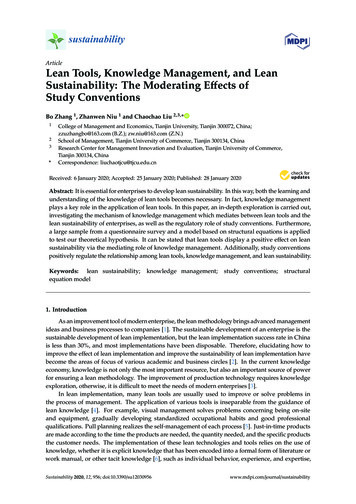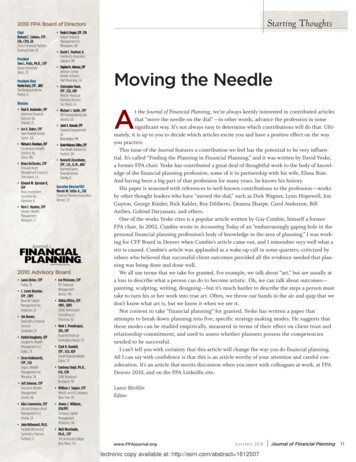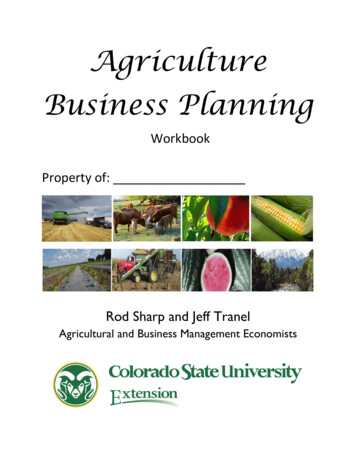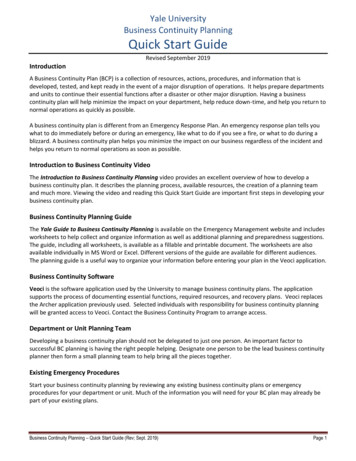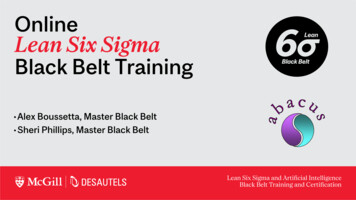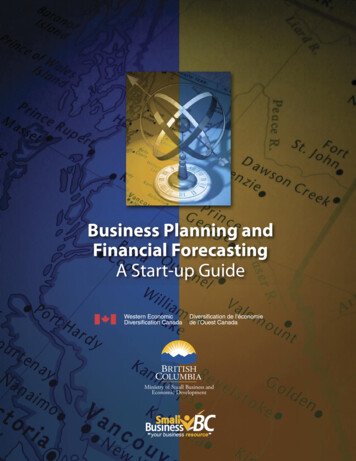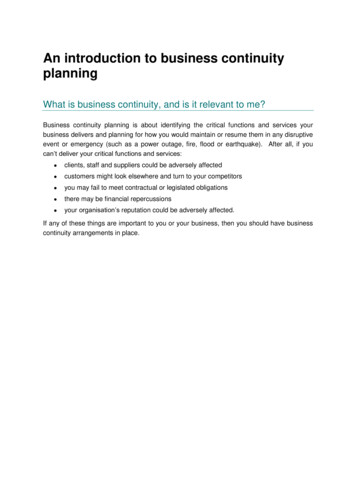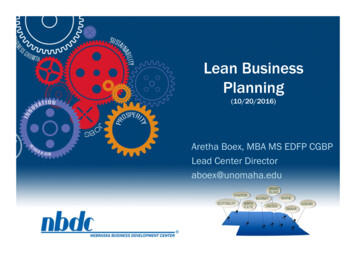
Transcription
Lean BusinessPlanning(10/20/2016)Aretha Boex, MBA MS EDFP CGBPLead Center Directoraboex@unomaha.edu
About NBDC Been around since 1977Statewide presence“Helping Good Businesses Become Better”Resource partner of the Small Business AdministrationServices for the life cycle of your business: Financial ManagementBusiness DevelopmentOperations Managementhttp://nbdc.unomaha.edu/
About the Presenter Graduate of the University of Nebraska at Omaha Professional Certifications Master of Business AdministrationMS – Management Information SystemsEconomic Development Finance ProfessionalCertified Global Business ProfessionalSeven years at NBDC – Omaha office 343 entrepreneurs served (YTD) 16,887,836 in capital infusions
Today’s AgendaIntroduction to business planning What is a business plan?The business plan documentHigh-Level Business Planning Lean business planningNBDC lean business canvasNext stepsQ&A
Introduction to BusinessPlanning
What is a business plan? It is NOT just a document The plan is a set of decisions (based on assumptions)that aim to ensure the success of a venture. Business planning is a process for deciding: What products or services to offerWhere to competeWhy customers will buyHow to accomplish goals
The business plan document (1) It has both internal and external uses The business plan helps you: organize your ideaslist out your assumptionsevaluate the overall business conceptprovide a sense of directionformulate a strategydetermine prioritiesapply for fundingIt’s a living document!
The business plan document (2)The term “business plan” is not used consistently. Traditional business plans Templates galoreBusiness model is knownDetailed and lengthyFocused on operationsOther “business plan” mentions When you are developing a productWhen the business model is unclearWhen you are applying for non-bank funds
High-Level BusinessPlanning
Lean Business Planning Describe the high-level strategyFocus on the overall business modelDiscover the revenue-generation modelList out assumptions
NBDC Lean Business Canvas Adapted from Alexander Osterwalder’s businessmodel canvas Source: Business Model Generation (Wiley, 2010)Nine key areas: ProblemsCustomersValue propositionSolutionChannelsRevenue StreamsCost StructureMetricsUnfair Advantage
Derived and modified from The Business Model Canvas (http://www.businessmodelgeneration.com)
LEAN CANVAS - INSTRUCTIONSPROBLEMSList here the 3 most important things thatwill be solved by this offering. Theyshould be “pain points” or strong“wants” in the marketplace. Rememberthat customers do not buy what theyneed. They buy what they want.SOLUTIONDescribe the product orservice that provides thesolution to the problems atleft.METRICSDescribe what measurableactions will effectively drivecustomers to the solution.VALUE PROPOSITIONEvery problem has more than onesolution. No product or service iswithout competition, if not directly thenwith acceptable or known alternatives.Describe why the product or service isthe best alternative for the customer.The value does not have to be low price.Value in a luxury good can be high price.The value is the description of the reasonwhy the customer will choose thisproduct or service over all otheralternatives.COST STRUCTURECost structure should include development, production, sales and delivery. The percent of costdevoted to personnel, overhead, production, inventory, receivables, and promotion shouldreceive attention. Try to think of every potential cost and how it will be handled in the businessstructure.UNFAIRADVANTAGESometimes called the“distinctive difference,” thisis the way in which theproduct or service can’t bematched by competitors.CHANNELSThis is the process of gettingthe product or service to themarket. Channels can beabout efficiency and qualitybut they can also be part ofthe value proposition.CUSTOMERSThis is a description of thecustomer. Any brand that has valuewill have persons devoted to it.That means it will also havepersons who don’t want it. Whoare they? Why do they think likethey do? Where do they live? Whatis their education level? What istheir income level? What is theirattitude toward unproven products?How will they purchase (online, inperson, through an agent, etc.)?REVENUE STREAMSDescribe how the product will be sold and revenue obtained. If it is through distributors,representatives, sales staff or other means then the cost structure at left should describe the cost offinancing the sales. In some high tech ideas, particularly online or smart phone apps, customersare obtained by free offers. Describe how these will be monetized.Derived and modified from The Business Model Canvas (http://www.businessmodelgeneration.com)
Next Steps Go over the canvas a many times as you need to.Develop a short narrative that covers the 9components.If you are applying for specific funding, find out therequirements and follow them!Call for clarifications.When your narrative is done, have it reviewed.Be prepared to “pivot” as needed.
Further Reading The Startup Owner's Manual (2012) The Lean Startup (2011) by Steve Blank and Bob Dorfby Eric RiesBusiness Model Generation (2010) by Alexander Osterwalder
Additional Information
This is the original Business Model Canvas.
This is an example of a moretraditional business plan outline.BUSINESS PLAN OUTLINEI.TITLE PAGETABLE OF CONTENTSII.EXECUTIVE SUMMARYIII. COMPANY PROFILEIV. MARKET RESEARCH AND ANALYSISa)b)c)V.Customer DescriptionMarket AnalysisCompetitive AnalysisMARKETING PLANa)b)c)d)e)f)Marketing ObjectivesProducts and ServicesPricingPromotionPlace (Location and Distribution)Ongoing Marketing EvaluationVI. OPERATIONSa)b)c)d)e)f)Business OperationsFacilityEquipmentBusiness FormsAccounting and Bookkeeping SystemSuppliersVII. HUMAN RESOURCES MANAGEMENTa)b)c)Local Labor Market ConditionsPersonnel ManagementOutside AssistanceVIII. FINANCIAL PLANa)b)c)d)e)f)g)h)Sources and Uses of FundsDepreciation ScheduleSales and Cost of Goods or Services Sold SchedulesLoan Amortization ScheduleIncome StatementCash Flow StatementBalance SheetBreakeven Analysis
EXAMPLES OF BUSINESS EXPENSESGENERAL ADMINISTRATIVE EXPENSESMARKETING EXPENSESSTART‐UP eesPayroll TaxesUtilities:ElectricityWater, GasTelephoneInternetTrash RemovalRent / LeaseRepair and MaintenanceCredit Card MachineBank ChargesAccountantBookkeepingLicenses and permitsDues and SubscriptionsInsurance ‐ General LiabilityInsurance ‐ Workers' CompInsurance ‐ OtherLegal Fees / AttorneyPostage / ShippingOffice SuppliesTraining expensesTravel expensesGrand Opening CeremonyAdversising AgencyYellow Pages AdvertisingBillboard AdvertisingTV / Radio AdvertisingNewspaper AdvertisingSocial Media AdvertisingNewsletter / Blog ExpensesBusiness Cards & LetterheadBrochures and FlyersLetters and PostcardsEvent SponsorshipTrade Shows / ExhibitionsBanners / SignsProduct SamplesGroupon PromotionsChamber of Commerce MembershipWeb Site Design & MaintenanceSearch Engine OptimizationeCommerce Features on Web SiteCustomer SurveysPromotional MailingProduct DevelopmentComputer EquipmentPOS SystemGeneral EquipmentToolsLand and BuildingBuilding Repairs / ImprovementsStarting InventoryLegal Fees (entity formation)PRODUCTION COSTSCost of MaterialsDirect Labor CostsOther Variable Costs
To find a consultant near you, please go tants.cfm
LEAN CANVAS - INSTRUCTIONS. VALUE PROPOSITION. Every problem has more than one solution. No product or service is without competition, if not directly then with acceptable or known alternatives. Describe why the product or service is the best alternative for the customer. The value does no


